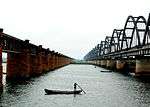Godavari River
| Godavari | |
| Dakshina Ganga | |
| River | |
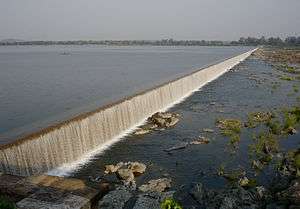 Dummugudem Barrage on Godavari in Khammam District | |
| Country | India |
|---|---|
| States | Maharashtra, Telangana, Chhattisgarh, Andhra Pradesh, Puducherry (Yanam) |
| Region | South India, Western India |
| Tributaries | |
| - left | Banganga, Kadva, Shivana, Purna, Kadam, Pranahita, Indravati, Taliperu, Sabari |
| - right | Nasardi, Darna, Pravara, Sindphana, Manjira, Manair, Kinnerasani |
| Cities | Nashik, Nanded, Ramagundam, Rajamundry, Bhadrachalam |
| Source | |
| - location | Brahmagiri Mountain, Tryambakeshwar, Nashik, Maharashtra, India |
| - elevation | 920 m (3,018 ft) |
| - coordinates | 19°55′48″N 73°31′39″E / 19.93000°N 73.52750°E |
| Mouth | |
| - location | Antarvedi into Bay of Bengal, East Godavari, Andhra Pradesh, India |
| - elevation | 0 m (0 ft) |
| - coordinates | 17°0′N 81°48′E / 17.000°N 81.800°ECoordinates: 17°0′N 81°48′E / 17.000°N 81.800°E [1] |
| Length | 1,465 km (910 mi) |
| Basin | 312,812 km2 (120,777 sq mi) |
| Discharge | |
| - average | 3,505 m3/s (123,778 cu ft/s) [2] |
| Discharge elsewhere (average) | |
| - Polavaram (1901-1979) | 3,061.18 m3/s (108,105 cu ft/s) [3] |
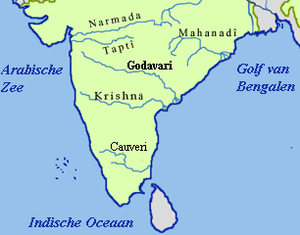 Path of the Godavari through the South Indian Peninsula | |
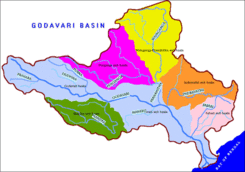
The Godavari is the second longest river in India after the river Ganges having its source at Tryambakeshwar, Maharashtra.[4] It starts in Maharashtra and flows east for 1,465 kilometres (910 mi) emptying into Bay of Bengal draining the Indian states Maharashtra (48.6%), Telangana( 18.8%), Andhra Pradesh (4.5%), Chhattisgarh (10.9%), Madhya Pradesh (10.0%), Odisha (5.7%) and Karnataka (1.4%)[5] through its extensive network of tributaries. Measuring up to 312,812 km2 (120,777 sq mi), it forms one of the largest river basins in the Indian subcontinent, with only the Ganges and Indus rivers having a drainage basin larger than it in India.[6] In terms of length, catchment area and discharge, the Godavari river is the largest in peninsular India and had been dubbed as the 'Dakshina Ganga' - the South Ganges river [7]
The river has been revered in Hindu scriptures since many millennia and continues to harbor and nourish rich cultural heritages. However, in the past few decades, the river has been abused with relentless construction of barrages and dams. The river delta, supporting 729 persons/km2 - nearly twice the density average for the nation, has been categorized as having substantial risk[8] to greater risk[9] of flooding with rising sea levels.
Course
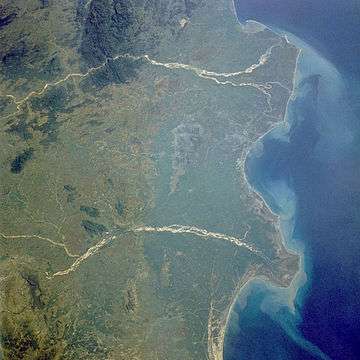

The Godavari originates 80 km (50 mi) from the Arabian Sea in the Western Ghats of central India near Nasik in Maharashtra. It flows for 1,465 km (910 mi), first eastwards across the Deccan Plateau then turns southeast, entering the West Godavari district and East Godavari district of Andhra Pradesh, until it splits into two watercourses that widen into a large river delta and flow into the Bay of Bengal.[11]
The Godavari River has a coverage area of 312,812 km2 (120,777 sq mi), which is nearly one-tenth of the area of India and is greater than the areas of England and Ireland put together. The river basin is considered to be divided into 3 sections:
- Upper (source to confluence with Manjira),
- Middle (between confluence of Manjira and Pranhita) and
- Lower (Pranhita confluence to mouth).
These put together account for 24.2% of the total basin area.[12] The rivers annual average water inflows are nearly 110 billion cubic metres.[13] Nearly 50% of the water availability is being harnessed. The water allocation from the river among the riparian states are governed by the Godavari Water Disputes Tribunal. The river has highest flood flows in India and experienced recorded flood of 3.6 million cusecs in the year 1986 and annual flood of 1.0 million cusecs is normal.[14][15]
Within Maharashtra
In Maharashtra state where it takes origin, the river has an extensive course, the upper basin (origin to its confluence with Manjira) of which lies entirely within the state, cumulatively draining an area as large as 152,199 km2 (58,764 sq mi) - about half the area of Maharashtra.[16] Within Nashik District the river assumes a north-easterly course till it flows into the Gangapur Reservoir created by a dam of the same name. The reservoir along with the Kashypi Dam provides potable water to Nashik, one of the largest cities located on its banks. The river as it emerges through the dam, some 8 km (5.0 mi) upstream from Nashik, flows on a rocky bed undulated by a series of chasms and rocky ledges, resulting in the formation of two significant waterfalls - the Gangapur waterfalls and the Someshwar Waterfalls, the latter, located at Someshwar and more popularly known as the Dudhsagar Waterfall [17] About 10 km (6.2 mi) east of Gangapur the river passes the town of Nashik where it collects its effluents in the form of the river Nasardi on its right bank.
About 0.5 km (0.31 mi) south direction from Nashik, the river bends sharply to the east, washing the base of a high cliff formerly the site of a Mughal fort, but which is now being eaten away by the action of floods. About 25 km (16 mi) below Nasik is the confluence of the Godavari and one of its tributaries, the Darna river. The stream occupies, for nine months in the year, a small space in a wide and gravelly bed, the greyish banks being 4 to 6 m (13 to 20 ft) high, topped with a deep layer of black soil. A few kilometres after its meeting with the Darna, the Godavari swerves to the north-east, till the Banganga, from the north-west, meets it on the left. The course of the main stream then tends more decidedly south. At Nandur-Madhmeshwar, the Kadva, a second large affluent, brings considerable increase to the waters of the Godavari. The river begins its southeasterly course characteristic of rivers of the Deccan Plateau. The river beyond exits the Niphad Taluka of Nashik and enter the Kopargaon taluka, Ahmednagar District. Within Ahmednagar the river quickly completes its short course, flowing alongside the town of Kopargaon and reaching Puntamba. Beyond this the river has been deployed as a natural boundary between the following districts :
- Ahmednagar and Aurangabad: Along the boundary here, it receives its first major tributary Pravara River, draining the former district, the confluence located at Pravarasangam. By virtue of a sub-tributary of Pravara - Mandohol, which originates in Pune District - the basin impinges the Pune District. The river at Paithan has been impounded by the Jayakwadi Dam forming the NathSagar Reservoir. Kalsubai located in Godavari basin, is the highest peak in Maharashtra.
- Beed and Jalna
- Beed and Parbhani: Located along here is its merger with Sindphana, an important tributary[18] which drains a considerably large area within Beed. The sub-tributary river Bindusara forms a landmark at Beed.
The river beyond, near the village Sonpeth, flows into Parbhani. Its course is relatively non-significant except for receiving two smaller streams - Indrayani and Masuli - merging at its left and right banks respectively. Within the last taluka of the district Parbhani, Purna, the river drains a major tributary of the same name: Purna[19]
It then exits into the neighboring district of Nanded where 10 km (6.2 mi) before reaching the town Nanded, is impounded by the Vishnupuri Dam and thus with it, bringing Asia's largest lift irrigation projects to life. A little downstream from Nanded, the river receives Asna, a small stream, on its left bank.It then runs into the controversial Babli project soon ends its course within Maharashtra, albeit temporarily, at its merger with a major tributary - Manjira.
The river after flowing into Telangana, re-emerges to run as a state boundary separating the Adilabad, Telangana from Gadchiroli, Maharashtra. At the state border, it runs between Sironcha and Somnoor Sangam receiving one tributary at each of those nodal points - the Pranhita and subsequently the Indravati.
Within Telangana
Godavari enters in to Telangana in Adilabad district at Basara. The river flows along the border between Adilabad in the north and Nizamabad, Karimnagar districts to its south. About 12 km (7.5 mi) after entering Telangana it merges with the back waters of the Sriram Sagar Dam. The river after emerging through the dam gates, enjoys a wide river bed, often splitting to encase sandy islands. The river receives a minor but significant tributary Kadam river. It then emerges at its eastern side to act as state border with Maharashtra only to later enter into Khammam district. In this district the river flows through an important Hindu pilgrimage town - Bhadrachalam.
The river further swells after receiving a minor tributary Kinnerasani River and exits into Andhra Pradesh.
Within Andhra Pradesh


Within the state of Andhra Pradesh, it flows through hilly terrain of the Eastern Ghats known as the Papi hills which explains the narrowing of its bed as it flows through a gorge for a few km
, only to re-widen at Polavaram. Before crossing the Papi hills, it receives its last major tributary Sabari River on its left bank. The river upon reaching the plains begins to widen out until it reaches Rajamundry. Arma Konda or Jindhagada Peak (1,680 m (5,510 ft) above msl) located near Paderu is the highest peak in the Godavari river basin as well as in Eastern Ghats.[20][21]
After crossing Rajahmundry, the Godavari splits into two branches which are called Vriddha Gautami (Gautami Godavari) and Vasishta Godavari. Again the Gautami branch splits into two branches namely Gautami and Nilarevu. Similarly the Vasishta splits into two branches named Vasishta and Vainateya. These four branches which join the Bay of Bengal at different places, are forming a delta of length 170 km (110 mi) along the coast of the Bay of Bengal and is called the Konaseema region. This delta along with the delta of the Krishna River is called the Rice Granary of South India.[22]
Tributaries
The major tributaries of the river can be classified[23] as the left bank tributaries which include the Purna, Pranhita, Indravati and Sabari River covering nearly 59.7% of the total catchment area of the basin and the right bank tributaries Pravara, Manjira, Manair together contributing 16.1% of the basin.
Pranhita is the largest tributary covering about 34% of its drainage basin. Though the river proper flows only for 113 km (70 mi), by virtue of its extensive tributaries Wardha, Wainganga, Penganga, the sub-basin drains all of Vidharba region as well as the southern slopes of the Satpura Ranges. Indravati is the 2nd largest tributary,known as the "lifeline" of the Kalahandi, Nabarangapur of Odisha & Bastar district of Chhattisgarh. Due to their enormous sub-basins both Indravati and Pranhita are considered rivers in their own right. Manjira is the longest tributary and holds the Nizam Sagar reservoir. Purna is a prime river in the water scarce Marathwada region of Maharashtra.
| Tributary | Bank | Confluence Location | Confluence Elevation | Length | Sub-basin area |
|---|---|---|---|---|---|
| Pravara | Right | Pravara Sangam, Nevasa, Ahmednagar, Maharashtra | 463 m (1,519 ft) | 208 km (129 mi) | 6,537 km2 (2,524 sq mi) |
| Purna | Left | Jambulbet, Parbhani, Marathwada, Maharashtra | 358 m (1,175 ft) | 373 km (232 mi) | 15,579 km2 (6,015 sq mi) |
| Manjira | Right | Kandakurthi, Renjal, Nizamabad, Telangana | 332 m (1,089 ft) | 724 km (450 mi) | 30,844 km2 (11,909 sq mi) |
| Manair | Right | Arenda, Manthani, Karimnagar, Telangana | 115 m (377 ft) | 225 km (140 mi) | 13,106 km2 (5,060 sq mi) |
| Pranhita | Left | Kaleshwaram, Mahadevpur, Karimnagar, Telangana | 99 m (325 ft) | 113 km (70 mi) | 109,078 km2 (42,115 sq mi) |
| Indravati | Left | Somnoor Sangam, Sironcha, Gadchiroli, Maharashtra | 82 m (269 ft) | 535 km (332 mi) | 41,655 km2 (16,083 sq mi) |
| Sabari | Left | Kunawaram, East Godavari, Andhra Pradesh | 25 m (82 ft) | 418 km (260 mi) | 20,427 km2 (7,887 sq mi) |
Other than these 7 principal ones, it has many smaller but significant ones draining into it.
Etymology

The river is sacred to Hindus and has several places on its banks,that have been places of pilgrimage for thousands of years. Amongst the huge numbers of people who have bathed in her waters as a rite of cleansing are said to have been the deity Baladeva 5000 years ago and the saint Chaitanya Mahaprabhu 500 years ago. Every twelve years, Pushkaram fair is held on the banks of the river.
A legend has it that the Sage Gautama lived in the Brahmagiri Hills at Trayambakeshwar with his wife Ahalya. The couple lived the rest of their lives in the then village "Govuru" which is now called "Kovvur"[Cow = ఆవు/గోవు] after the British rule. Ahalya lived in a nearby place "Thagami" which in due course of time changed to the name "Thogummi". The Rishi as a reason for Annadanam (The nature of giving away food), started cultivating rice crops and other crops. Once, a holy cow (maaya-dhenu) created by Lord Ganesh on the wish of munis, which resembled a normal cow entered his abode and started spoiling the rice while he was meditating. Knowing that a cow shall not be treated harshly, he put the dharbha grass on the cow and to his surprise it fell dead. The munis and muni-patnis said “we thought that Gautama maharshi is an Uttama, but he did Go-hatya!”. The Rishi wished to atone for the sin of ‘Gohathya’ - killing a sacred cow. He went to Nashik and did Tapas to Lord Tryambakeshwar (Lord Shiva) on the advice of the other rishis. The rishi requests the lord to release him from the sin by making the River Ganges flow over the cow. Lord Shiva was pleased with the Rishi and diverted the river Ganges to flow over the cow where it died which is in "Govuru". The River Godavari is thus born in Nashik and flowing past the village Kovvur and merge with the Bay of Bengal at last.
Settlements along the Godavari
In Maharashtra:
- Nashik (Holy city and site of Simhastha Kumbha Mela bathing festivals)
- Trimbakeshwar (shrine to the Jyotirlinga of the god Shiva)
- Kopargaon
- Puntamba - A place of pilgrimage with a number of ancient temples including the last resting place (Samadhi) of Sant Changdev in Puntamba.
- Paithan (Ancient capital of the Satavahana dynasty)
- Gangakhed
- Nanded (Location of the Hazur Sahib Nanded Sikh gurdwara)
- Sironcha (Town situated near the confluence of Godavari and Pranahita rivers)

In Telangana:
- Basara, Adilabad (Gnana Saraswati Temple)
- Goodem gutta, Adilabad (Temple) Luxettipet, Adilabad.
- Mancherial, Adilabad
- Nirmal, Adilabad (Nirmal Toys)
- Chennur, Adilabad
- Tadpakal, Nizamabad (Armoor Toys)
- Battapur, Nizamabad (Armoor Toys)
- Dharmapuri, Andhra Pradesh|Dharmapuri, Karimnagar (Narasimha Swamy Temple)
- Godavarikhani, Karimnagar
- Manthani, Karimnagar (Gautameshwara Swami (Siva) Temple, Sri Rama, Sarswathi Temples)
- Kaleshwaram, Karimnagar (Kaleswara Mukhteswara swamy (Siva) Temple)
- Mahadevpur
- Eturunagaram, Warangal
- Bhadrachalam, Khammam
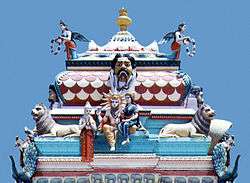
In Andhra Pradesh:
- Rajamundry, East Godavari (Sri Kotilingeswara Alayam)
- Mukteswaram, East Godavari (Sri Kshana Muktheswaraswamivari Devalayam)
- Ravulapalem, East Godavari
- Dowleswaram, East Godavari (Where the Akhanda Godavari splits into two streams called "Vriddha Gautami" and "Vashista" before joining Bay of Bengal)
- Kotipalli, East Godavari (Sri Someswaraswamivari Alayam)
- Antarvedi, East Godavari (Antarvedi is famous for the Sri Laxmi Narasimhaswamivari Mandhiram constructed between the 15th and 16th centuries. There is also a temple of Lord Siva that is older than Narasimha Swamy temple. The temple's idol of Lord Siva was installed by Lord Srirama.
- Yanam (Yanam is located in East Godavari District, where the Vriddha Gautami joins Bay of Bengal)
- Polavaram, West Godavari (Sri Bhadrakalisametha Sri Veereswaraswamivari Mandhiram)
- Pattiseema, West Godavari (Sri Veerabhadraswamivari Devalayam)
- Kovvur, West Godavari (Sundareswaraswamivari Alayam)
- Tallapudi, West Godavari
- Narsapur, West Godavari
Places of interest
Sites of pilgrimage include:
- Basar (originally, Vyasara) - Sri Gyana Saraswati temple is situated on the banks of Godavari in Adilabad district, Telangana. It is 210 km from state capital Hyderabad and accessible by road and rail (nearest major station: Nizamabad, although Basar station also exists). It is considered that the sage Vyasa wrote the Mahabharata on the banks of Godavari at this location near Harsha house it is the beautiful scenario, and thus the place came to be known as Vyasara.
- Bhadrachalam - Hindu Temple of Lord Rama.
- Dharmapuri, Telangana - Hindu Temple of Lord Narasimha. Godavari flows from north to south in Dharmapuri, hence the river is locally called 'Dakshina Vahini' [South Flowing]
- Kaleshwaram - Sri Kaleswara Mukhteswara swamy Temple is situated here on the banks of Triveni sangamam of rivers godavari and pranahita. It is 125 kilometres away from Karimnagar city, 115 km away from Warangal city.
- Trimbakeshwar - One of the twelve Jyotirlingas and ancient temple of Lord Shiva.
- Nanded - Takht Sri Hazur Sahib, one of the five most sacred places in Sikhism.
- Nashik - One of the four Sinhastha Kumbh Mela, Hindu pilgrimage place.
- Paithan - Saint Eknath's native place, famous Jayakwadi dam, and a beautiful garden named after Sant Dnyneshwar.

- Antarvedi, East Godavari (Antarvedi is famous for the Laxmi Narasimha Swamy temple constructed between the 15th and 16th centuries. There is also a temple of Lord Siva that is older than Narasimha Swamy temple. The temple's idol of Lord Siva was installed by Lord Srirama.
- Konaseema - Delta of Godavari.
- Pattiseema - A village where a Hindu temple is located on a small hill on an island in the river.
- Kovvur - A village where cows resided and a place where the maaya-dhenu fell dead. Footprints of the maaya-dhenu were seen even today in the famous place Kovvur called "Goshpadakshetram" also called "Gopadala Revu" where the footprints of the holy cow are seen near the temple of Lord Shiva. Also a village which is the reason for the birth of river Godavari. Famous for a Sanskrit school which has been built 63 years back.
- Rajahmundry - A town known for its role in Telugu culture and birthplace of writers such as Nannaya, one of the Kavitrayam trinity of poets who translated the Mahabharata into Telugu. The Godavari Pushkaralu is a major local festival that is staged every 12 years.
- Araku Valley which is a popular hill station in Vishakhapatnam District.
- Lambasingi hill station known for snowfall during winter season in Vishakhapatnam district.
- Deomali peak located in the Godavari basin is the highest peak (1672 m msl) in Odisha state.
Flora and Fauna
- The Krishna Godavari Basin is one of the main nesting sites of the endangered Olive Ridley sea turtle. Godavari is also a home to the endangered fringed-lipped carp (Labeo fimbriatus).[25]
- The Coringa mangrove forests in the Godavari delta are the second largest mangrove formation in the country. Part of this has been declared as the Coringa Wildlife Sanctuary, renowned for reptiles. They also provide an important habitat to a wide variety of fish and crustaceans. These forests also act as barriers against cyclones, tropical storms and tidal waves thus protecting the nearby villages.
- The Jayakwadi Bird Sanctuary is another haven for birds located near the town of Paithan spread across the back waters of the NathSagar Reservoir formed by impounding the Godavari by the massive Jayakwadi Dam. Its 341 km2 area is dotted by islands within the reservoir which serve as nesting sites for the birds.[26]
- The Nandurmadmeshwar Bird Sanctuary is located along the back waters of the Godavari river near Nashik at its confluence with Kadva River.[27] It is known as the Bharatpur of Maharashtra for the wide diversity of bird life that it harbours.
The following are few other wildlife sanctuaries located in the river basin.
- Papikonda Wildlife Sanctuary
- Indravati National Park
- Kanger Ghati National Park
- Eturnagaram Wildlife Sanctuary
- Kawal Wildlife Sanctuary
- Kinnerasani Wildlife Sanctuary
- Manjira Wildlife Sanctuary
- Pocharam Forest & Wildlife Sanctuary
- Pranahita Wildlife Sanctuary
- Tadoba Andhari Tiger Project
- Pench National Park
- Bor Wildlife Sanctuary
- Navegaon National Park
- Nagzira Wildlife Sanctuary
- Gautala Wildlife Sanctuary
- Tipeshwar Wildlife Sanctuary
- Painganga Wildlife Sanctuary
Waterfalls
Duduma Waterfalls is 175 metres (574 ft) high and one of the highest waterfalls in southern India. It is located on the Sileru river which forms boundary between Andhra Pradesh and Odisha states. The following are few other waterfalls located in the river basin

Crossings

There are 3 railway bridges spanning the river between East Godavari and West Godavari districts.
- Old Godavari Bridge (also known as Havelock bridge, and named after then Madras governor)
- Godavari Bridge (also known as Rail-cum-road bridge and Kovvur-Rajahmundry Bridge)
- Godavari Arch Bridge (also known as New railway bridge)
- Fourth Bridge (also known as new road bridge)
- Old Godavari Bridge
Construction of this bridge started in 1876, and was completed in 1897. It was constructed under the supervision of F.T. Granville Walton who had constructed the Dufferin Bridge over the Ganges, and Granville Mills, both British engineers. Spanning over 3 km in length, it linked the East Godavari and West Godavari districts. The bridge has been a vital link enabling trains to run between Chennai and Howrah. Trains continued over the bridge for a century until 1997, when train services over the bridge were suspended after the construction of two additional bridges.
- Godavari Bridge
This bridge constructed over a quarter of a century ago, serves as both a railway bridge and as a roadway between the East Godavari and West Godavari Districts.
- Godavari Arch Bridge
This bridge was completed in 1997, was built upstream of the earlier bridges.
Fourth Bridge
This bridge is open to public from Godavari Pushkaras 2015. This is a road connectivity bridge link supposed to ease traffic flow between Rajamundry and Kovvur
Dams


The main Godavari river up to the confluence with Pranhita tributary is dammed fully to utilise the available water for irrigation. However, its main tributaries Pranhita, Indravati and Sabari which join in the lower reaches of the basin, carry three times more water compared to main Godavari. In the year 2015, the water surplus Godavari river is linked to the water deficit Krishna river by commissioning the Polavaram right bank canal with the help of Pattiseema lift scheme to augment water availability to the Prakasam Barrage located in Andhra Pradesh. Maximum number of dams are constructed in Godavari river basin than in any other river basin of India.[28] The following are the few dams located in the river basin:
- Gangapur Dam : This is a large earth fill dam with gross water storage of 215.88 million cubic metres,[29] and located 10 km (6.2 mi) upstream from Nashik city. The reservoir known as the Gangapur Bandh Sagar provides drinking water to the Nashik city and also supplies water to the thermal power station situated downstream at Eklahare.
- Jayakwadi dam : Located near Paithan, it is one of the largest earthen dams in India. This dam was built to address the dual problems of flooding along the banks, during monsoon months, and that of drought, rest of the year, in the Marathwada region. Two 'left' and 'right' canals provide the irrigation to fertile land up to Nanded district. This dam has contributed to industrial development of Aurangabad and Jalna, Maharashtra.[30] Majalgaon Dam is also constructed under Jayakwadi stage 2 to expand the irrigation potential further in Parbhani, Nanded and Beed districts.
- Vishnupuri barrage: Asia's Largest Lift Irrigation project, the Vishnupuri Prakalp[31] has been constructed on the river at a distance of 5 km (3.1 mi) from the city Nanded.
- Ghatghar Dam was built for hydro power generation by diverting the water of Pravara tributary outside Godavari river basin to a west flowing river which joins Arabian sea.
- Upper Vaitarna reservoir was built across west flowing Vaitarna river merging some part of Godavari river catchment area. Godavari water impounded in this reservoir is diverted outside the river basin for Mumbai city drinking water supply after generating hydro power.
- Sriram Sagar Dam : This is another multipurpose project on the Godavari River on the borders of Adilabad and Nizamabad District. It is near the town of Pochampad, 60 km away from Nizamabad. It has been described by The Hindu as a "lifeline for a large part of Telangana".[32] It serves the irrigation needs in Karimnagar, Warangal, Adilabad, Nalgonda, and Khammam districts and also generates power.
- Dowleswaram Barrage was built by Sir Arthur Cotton in 1852. It got damaged in 1987 floods, and rebuilt as a barrage cum roadway soon after and named after him. The roadway connects Dowleswaram in East Godavari and Vijjeswaram in West Godavari. The irrigation canals of this barrage also form part of National Waterway 4.
Hydro power stations

Godavari river is one of the rivers whose water energy is least harnessed for generating hydro electricity.[33] Many hydro power projects with storage reservoirs are held up due to forest submergence and population displacement difficulties.[34] 600 MW capacity Upper Indravati hydro power station is the biggest hydro power station which diverts Godavari river water to the Mahanadi river basin.[35] The following is the list of hydro electric power stations excluding small and medium installations.
| Name of the project | Rated Power (in MW) |
|---|---|
| Upper Indravati | 600 |
| Machkund | 120 |
| Balimela | 510 |
| Upper Sileru | 240 |
| Lower Sileru | 460 |
| Upper Kolab | 320 |
| Pench | 160 |
| Ghatghar pumped storage | 250 |
| Polavaram (under construction) | 960 |
Mineral deposits
Godavari river basin is endowed with rich mineral deposits such as oil & gas, coal, iron, lime stone, manganese, copper, bauxite, granite, laterite, etc. The following are the few noted deposits:
- Krishna Godavari Basin, oil & gas
- Godavari Valley Coalfield, coal
- Wardha Valley Coalfield, coal
- Pench Kanhan Coalfield, coal
- Bailadila iron, iron
- Rowghat Mines, iron
- Araku hills, bauxite
- Malanjkhand, copper
- MOIL, manganese
Ecological concerns
The frequent drying up of the Godavari river in the drier months has been a matter of great concern. Indiscriminate damming along the river has been cited as an obvious reason. Within Maharashtra sugarcane irrigation has been blamed as one of the foremost causes.[36]
In 2013, the river was at its all-time low in the Nizamabad district of Telangana. This had hit the growth of fish, making the life of fishermen miserable.The water-level was so low that people could easily walk into the middle of the river. Shortage in rainfall and closure of the controversial Babli project gates in Maharashtra was thought to have affected the water flow in the river and water availability to the Sriram Sagar Project except during above 20% excess monsoon (i.e. one out of four years) years.[37]
A study has found that the delta is at a greater risk as the rate of sediment aggradation (raising the level of the delta through sediment deposition) no longer exceeds relative sea-level rise.[38] It further states that the suspended sediment load at the delta has reduced from 150·2 million tons during 1970–1979 to 57·2 million tons by 2000–2006,[39] which translates into a three-fold decline in the past 4 decades. Impacts of this can be seen in destroyed villages like Uppada in Godavari delta,[40] destruction of Mangrove forests and fragmentation of shoreline - possibly a fallout of dam construction.
Said to further epitomise the insensitivity towards Godavari, is the Polavaram Project which is touted to be gigantic - both in terms of size and violations.[41] Deemed as being pointless and politically driven,[42] the project raises questions about environmental clearance, displacement of upstream human habitations,[43] loss of forest cover, technicalities in the dam design which are said to play down flood threats and unsafe embankments.
High alkalinity water is discharged from the ash dump areas of many coal fired power stations into the river which further increases the alkalinity of the river water whose water is naturally of high alkalinity since the river basin is draining vast area of basalt formations.[44] This problem aggravates during the lean flow months in entire river basin. Already the Godavari basin area in Telangana is suffering from high alkalinity and salinity water problem which is converting soils in to unproductive sodic alkali soils.[45] The following are the few coal fired power stations located in the river basin:
| Name of Power Station | Rated Power (in MW) |
|---|---|
| Koradi Thermal Power Station | 2,600 |
| Khaparkheda Thermal Power Station | 1,340 |
| Tirora Thermal Power Station | 3,300 |
| Butibori Power Project | 600 |
| RattanIndia Nashik TPS | 1,350 |
| Chandrapur STPS | 3,340 |
| Mauda Super Thermal Power Station | 1,000 |
| Parli Thermal Power Station | 1,130 |
| Dhariwal Power Station | 300 |
| Nashik Thermal Power Station | 910 |
| Wardha Warora Power Plant | 540 |
| Pench Thermal Power Plant | 1,320 |
| Lanco Vidarbha Thermal Power | 1,320 |
| NTPC Ramagundam | 2,600 |
| Kothagudem Thermal Power Station | 1,720 |
| Kakatiya Thermal Power Station | 1,100 |
| Ramagundam B Thermal Power Station | 60 |
| Manuguru Heavy water plant's power station | N/A |
| Singareni thermal power station | 1,800 |
| Bhadradri Thermal Power Plant | 1,080 |
Culture and News
One of the ships of the Indian Navy has been named INS Godavari after the river.
See also
References
- ↑ Godāvari River at GEOnet Names Server
- ↑ Kumar, Rakesh; Singh, R.D.; Sharma, K.D (2005-09-10). "Water Resources of India" (PDF). Current Science. Bengaluru: Current Science Association. 89 (5): 794–811. Retrieved 2013-10-13.
- ↑ "Sage River Database". Archived from the original on June 21, 2010. Retrieved 2011-06-16.
- ↑ "Godavari river basin map"
- ↑ "Integrated Hydrological DataBook(Non-Classified River Basins)" (PDF). Central Water Commission. p. 9. Retrieved 2015-10-13.
- ↑ http://india-wris.nrsc.gov.in/wrpinfo/index.php?title=Basins
- ↑ "Dakshina Ganga (Ganga of South India) – River Godavari". Important India. Retrieved 2015-10-21.
- ↑ http://www.igbp.net/download/18.62dc35801456272b46d4b/1398850074082/NL82-Deltas_infographic.pdf
- ↑ South Asia Network on Dams Rivers and People (2014). "Shrinking and Sinking Deltas: Major role of Dams in delta subsidence and effective sea level rise" (PDF). Retrieved 15 January 2016.
- ↑ "India: Andhra Pradesh Flood 2005 situation report, 21Sep 2005". 29 May 2014. Retrieved 15 January 2016.
- ↑ "Godavari basin status report, March 2014" (PDF). Retrieved 15 November 2015.
- ↑ "Rivers of Western Ghats". Retrieved 2006-12-09.
- ↑ "Spatial variation in water supply and demand across river basins of India" (PDF). IWMI Research Report 83. Retrieved 23 June 2015.
- ↑ "When Bhadrachalam was under a sheet of water". Retrieved 26 May 2014.
- ↑ "Water flow data at Polavaram". Retrieved 26 May 2014.
- ↑ http://www.nih.ernet.in/rbis/basin%20maps/godavari_about.htm
- ↑ "Dudhsagar Waterfalls, Nashik". Nashik Directory. Retrieved 2015-10-18.
- ↑ "Beed district". Government of Maharashtra. Retrieved 15 January 2016.
- ↑ "Subbasin of Godavari". Hydrology and Water Resources Information System for India. Retrieved 2015-10-21.
- ↑ "Arma Konda, India". Retrieved 22 January 2015.
- ↑ "Mountain peaks database". Retrieved 15 November 2015.
- ↑ Kakani Nageswara Rao, et al.; Holocene environmental changes of the Godavari Delta, east coast of India, inferred from sediment core analyses and AMS 14C dating, Geomorphology, 175-176 (2012) pp.163–175
- ↑ Central Water Commission (2012). "Integrated Hydrological Data Book (Non - classified river basins" (PDF). Retrieved 15 January 2016.
- ↑ "Hydrology and water resources information for India". www.nih.ernet.in. National Institute of Hydrology,India. Retrieved 19 October 2015.
- ↑ Venkateshwarlu, K. (2012-05-03). "Godavari". The Hindu. Retrieved 2012-05-16.
- ↑ Maharashtra Forest Department. "Aurangabad Circle". Retrieved 15 January 2016.
- ↑ Nashik. "Nandur Madhmeshwar Bird Sanctuary". Retrieved 15 January 2016.
- ↑ "Dams in Godavari basin". Retrieved 2015-10-17.
- ↑ "Dams in Nashik District". National Informatics Centre (NIC), Collectorate, Nashik. Retrieved 2015-10-17.
- ↑ vijdiw. "Jaikwadi Dam and Its Nath Sagar Reservoir". authorstream.com. Retrieved 15 January 2016.
- ↑ "Vishnupuri barrage B00473". Retrieved 30 July 2016.
- ↑ Maharashtra projects hit Sriram Sagar project inflows: BJP. The Hindu, May 16, 2005
- ↑ "Power Houses in Godavari Basin". Retrieved 27 March 2015.
- ↑ "Proposed projects on Indravati river" (PDF). Retrieved 4 January 2015.
- ↑ "Upper Indravati Power_House PH01496". Retrieved 27 March 2015.
- ↑ Pawar, Yogesh (18 March 2013). "Krishna, Godavari basins drying up". Retrieved 15 January 2016.
- ↑ J. Keller, A. Keller and G. Davids. "River basin development phases and implications of closure" (PDF). Retrieved 25 August 2012.
- ↑ R Prasad. "Sinking Indian deltas put millions at risk". The Hindu. Retrieved 15 January 2016.
- ↑ South Asia Network on Dams, Rivers and People (2014). "Godavari's Story". Retrieved 15 January 2016.
- ↑ B Hema Malini; K Nageswara Raol (10 November 2004). "Coastal erosion and habitat loss along the Godavari delta front - a fallout of dam construction (?)" (PDF). Current Science. p. 1232. Retrieved 15 January 2016.
- ↑ Mahapatra, Richard (2011). "Polavaram fraud". Retrieved 15 January 2016.
- ↑ Times of India (5 July 2015). "Polavaram dam works to begin on Oct. 22". Retrieved 15 January 2016.
- ↑ Rediff News (29 May 2014). "Telangana bandh over Modi govt's ordinance on Polavaram". Retrieved 15 January 2016.
- ↑ Chemical weathering in the Krishna Basin and Western Ghats of the Deccan Traps, India
- ↑ "Alkalinity and salinity bane of soil in T state". Retrieved 23 October 2015.
External links
| Wikimedia Commons has media related to Godavari River. |
- Rivers Network: Godavari watersheds webmap
- Godavari River in 1911
- Nashik City
- Contrasting Behavior of Osmium in the Godavari River Estuary, India, 2001
- Variations of Monsoon Rainfall in Godavari River Basin
- irfca.org


.jpg)
